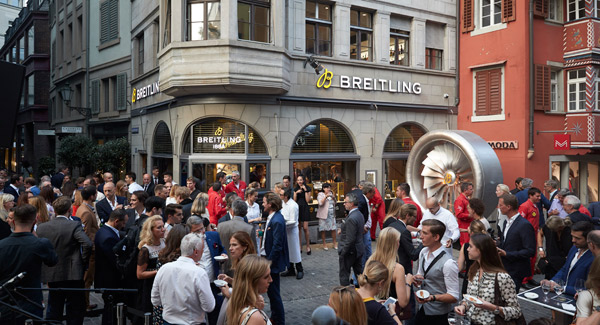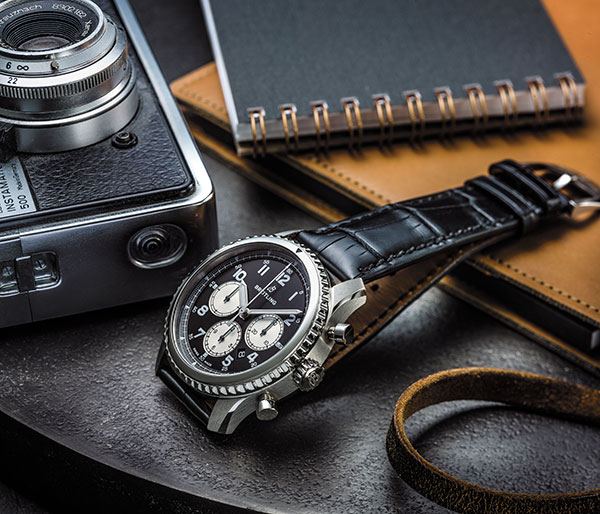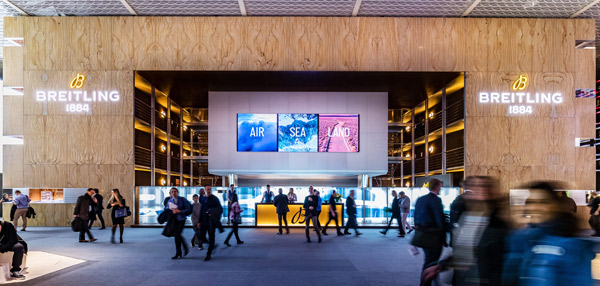It’s a year now since Georges Kern began travelling the world to spread the good news: Breitling is back. When he took up the position in August 2017 all we had was his word for it. But now we’re starting to see some results. And so the CEO took up his pilgrim’s staff once again, and went to meet the press, to present some conclusions from his first year. The reopening of the Zurich boutique on 28 August 2018 presented the perfect opportunity.
A self-assessment, by its very nature, opens one up to criticism, which may be more or less constructive. To Mr Kern’s credit, he submitted willingly to the ensuing barrage of questions, despite not being obliged to do so – clear evidence of a desire to be transparent and open. On the other hand, because he had no hard figures to back up his claims, it remains unclear whether his statements about growth will withstand scrutiny.
Downsized distribution and taking back control
But that didn’t stop the CEO claiming, in the absence of any financial data, that Breitling “is a profitable company, as it has always been. Given that Breitling is less strong in Asia, we were spared the worst of the crises, particularly in China.” The company restructuring plan continues with the stated aim, over three years (two of which are left), to reduce the 2000 points of sale down to 1400, with a clear desire to bring that number down even further. Distributors have also been given an ultimatum: “60% to 65% of sales continue to be made through agents, but over 80% of our distribution network will be integrated within the next 6 to 8 months.”
At the same time, there will be more monobrand stores: “We have around 70, 25 of which belong to us outright; the others are operated by agents. These own-brand stores are essential for controlling both our image and the grey market,” Georges Kern explains. In addition to the Zurich store, which reopened on 28 August , the Paris boutique is due to be renovated, and the German market will see its first Breitling store very soon. That’s no accident: the company confirmed that France and Germany are its two most delicate European markets.

Reconciling buyers and collectors
The CEO is keeping a very close eye on both the grey market and the collectors’ market. And with good reason. Breitling as a brand has never capitalised on its heritage (no museum, no publicly accessible archives, no certificate of authenticity, no Heritage Department). Over time, the two worlds – new watch buyers, and vintage collectors – have become diametrically opposed to each other.
Breitling’s strategy is twofold: to find a way of getting these two worlds to talk to each other, and to gain greater control over its second-hand market. There have been off-the-record hints that the company is thinking about setting up its own CPO (“Certified Pre-Owned”) scheme, under which second-hand Breitlings would be serviced, authenticated, guaranteed and sold by Breitling itself. But wouldn’t that risk harming new watch sales? “I don’t think so,” explains Georges Kern. “A BMW with 50,000 km on the clock isn’t competing with a brand new model that’s just arrived on the saleroom floor.”
From the Navitimer 8 to the Premier
In terms of products, the ranges will continue to be rationalised. The Navitimer has been launched, and “70% of its buyers are new to Breitling,” says Georges Kern, visibly pleased. A new Premier will be launched by year end, and the Superocean is still going strong in its Heritage incarnation. The partnership with Tudor “is confirmed, because we all win: the client, Breitling and Tudor,” stresses Georges Kern. The idea of a Breitling manufacture movement being granted to a brand other than Tudor is not on the cards, “But we’re independent; we’re not going to remain reactive, restricted by dogma,” notes the CEO.

Baselworld and the Breitling Jet Team: reading the tea leaves
How the company deals with Baselworld and its Breitling Jet Team will be telling. As far as the Jet Team is concerned, the manufacture has been a partner of the civilian aerobatics team for 16 years. Their contract expires in 2019. Will it be renewed? Watch this space. Georges Kern professes to “believe strongly in our Squads [Ed: the brand’s latest PR concept], in collective strength; I don’t believe in individualisation any more.”
On the face of it, it would seem that the Jet Team collective (seven jets in formation) is a good fit with the CEO’s wishes. But on the other hand, it symbolises the historic Breitling of the Schneider family and, probably, too strong an association with aeronautics, from which Georges Kern is seeking to distance the brand somewhat, in favour of forging closer ties with land and sea. “When you’re pigeonholed in aviation it’s very difficult to do new things. After a time, you find you’re always repeating the same ideas, from the 50s, 60s and 70s, when Breitling was very strong.”
As far as Baselworld is concerned, relations have cooled. On 27 March 2018 the CEO stated: “With some new ideas and the goodwill of everyone involved, the Baselworld fair has a fine future ahead of it.” Six months later, Swatch Group’s U-turn came like a bucket of cold water. Georges Kern echoed the general sentiment. “It’s absolutely unbelievable that they didn’t see it coming, when it was all happening right before their eyes,” he says today. “With the rise of globalisation we have lost out on proximity.” Could that be a parting shot across Baselworld’s bows?







